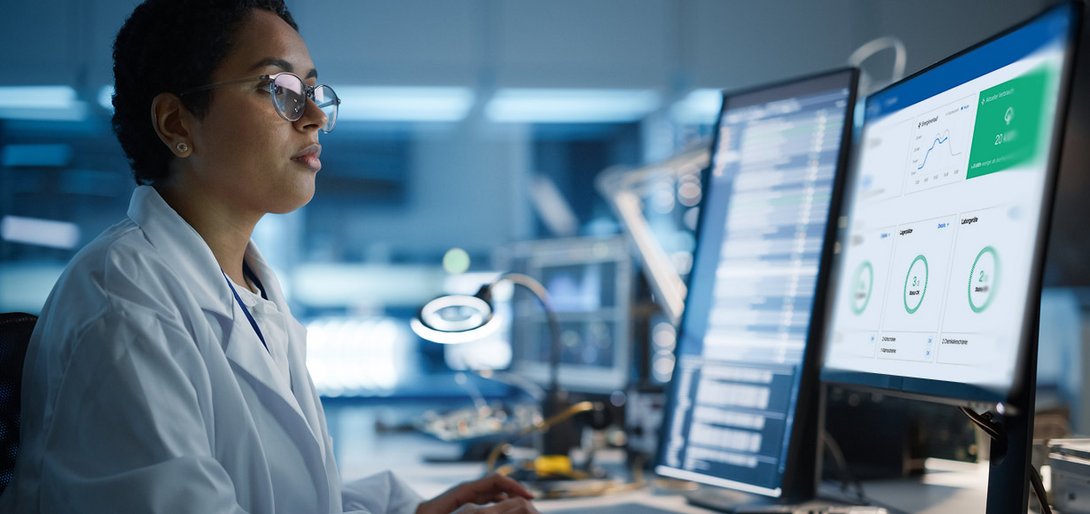The laboratory of the future is digital
It’s a futuristic vision, for now – the fully automated laboratory in which all processes are fully digitalised. Waldner is already taking an important step in this direction. With the new “Lab Control Center” (LCC) solution, fume hoods in laboratories can be monitored and controlled remotely. And in the future, many other things will be possible when it comes to laboratory digitalisation.
The laboratory of the future is digital
The year is 2030. All laboratory processes can be mapped on a single microchip and controlled via a mobile device. Fume hoods, laboratory devices, samples and all the laboratory equipment are connected to the central control unit via a cyber network. All components are fully networked, communicate with each other and constantly exchange information. Admittedly, this future scenario is not yet reality. However, it does already exist in the minds of those responsible, which paves the way for corresponding research initiatives on a global level. That’s why the industry is working flat out to digitalise laboratory workflows and in the near future to turn the scenario outlined into reality. We are now taking a pioneering step in this direction by digitally mapping the processes involved in laboratory fume hood management for the first time.
Monitoring, checking and controlling laboratory processes in real time
The newly developed software solution “Lab Control Center (LCC)” has been developed for this purpose. This software records, collects and displays a wide variety of data generated in the laboratory – such as measurements of temperature, humidity or brightness. It is true that such information has been collected and exchanged with building management systems for a long time. What is new, however, is that thanks to the LCC, the data is shown in compact form on a display by means of a dashboard and made available to laboratory users as additional data for their experiments. Users can thus monitor, check and control certain functions and processes in the laboratory in real time, either on site or remotely. In particular, measurements from the fume hoods and room parameters such as temperature, status of the fume hoods, operating mode, utilisation, pressure and energy consumption are displayed.
The LCC solution thus enables a previously unattained level of transparency. This allows laboratory staff to benefit from a wide range of advantages. For example, they can see at a glance whether the fume hoods are working properly and if all values are in the green zone – or whether intervention is necessary to maintain laboratory operation. Faults and malfunctions, such as a low flow rate in the fume hood, can be detected and localised quickly and accurately, so that they can be remedied promptly by the LCC itself or by a service technician. The data can also be used for optimal predictive maintenance of the laboratory environment. This helps to avoid downtime during operation and thus to maintain the quality standards at a consistently high level. In the first stage of development, LCC is not focusing exclusively on fume hoods; the inclusion of other laboratory equipment such as cooling and heating cabinets, heating plates, chemicals cabinets and disposal modules is also planned.
Optimising the safety of laboratory operations and employees
Another advantage is that by continuously monitoring and analysing relevant parameters, the safety of laboratory operations and staff can be taken to a whole new level. If the system detects, for example, that critical limit values have been exceeded, countermeasures can be taken at an early stage in order to avoid risks to the health of the employees or damage to the laboratory equipment. At the same time, the recorded data can also be used as a source of information for other digital systems in the laboratory or the building management system. “The Lab Control Center offers the necessary interfaces to seamlessly integrate a wide variety of sensors and laboratory equipment via plug and play. We are thus paving the way for the fully digitalised, cloud-based integrated laboratory infrastructure of the future,” notes Moriz Walter, Head of Product Development at Waldner Laboreinrichtungen.
Furthermore, the solution creates the necessary transparency to support and promote the sustainability of laboratory processes: Through the continuous display of measured values on temperature and energy development, operators receive an overview of the current energy consumption. This provides the basis for developing concepts and concrete measures to increase energy efficiency based on real data – without losing sight of the safety of the processes and the users. After all, the protection of laboratory staff has top priority.
Two competent partners are providing support for product development
Although we were in charge of the development of the Lab Control Center, other external teams were also involved, e.g in programming of the user interface as well as the connection of the data sources to the backend. “We brought two very experienced partners on board, both of whom have backgrounds in the laboratory sector and thus know the technological requirements inside out. In this way, we combine our know-how and develop an optimal solution for our customers.” explains Moriz Walter.
Where is the journey taking us now?
One thing is clear: The digitalisation of laboratory spaces is advancing at a rapid pace. The systems are becoming more and more complex and the number of data sources is increasing dramatically, which means that the data volumes are growing immeasurably. Therefore, in the future, it is to be expected that companies will push ahead with the research and development of digital laboratory solutions at full speed. This paves the way for increasing automation of processes and almost seamless documentation with little effort on the part of personnel. Thus, the future scenario of an end-to-end digitalised laboratory as described at the beginning of this article will probably soon become reality.
